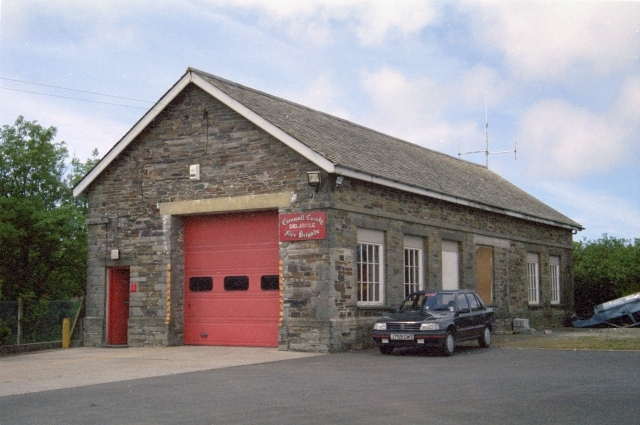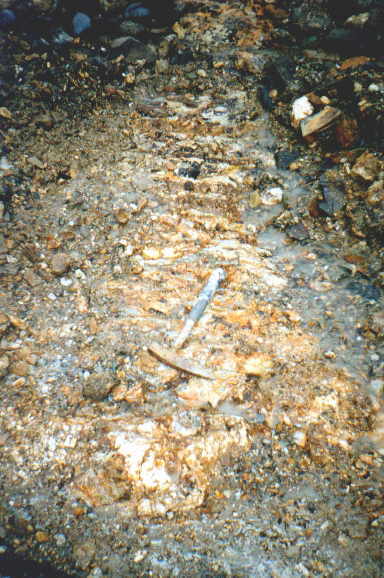|
Killas
Killas is a Cornish mining term for metamorphic rock strata of sedimentary origin which were altered by heat from the intruded granites in the English counties of Devon and Cornwall. The term is used in both counties. Origin The deposition of the killas strata occurred during the Devonian and Carboniferous geological periods. The sediments are not evenly spread over the county, with the Carboniferous beds only found in the far north of Cornwall. The depositional environments of the killas were very varied, as is revealed by the fossil content and the sedimentary sequences. The fossils indicate changes from anaerobic, deep ocean-basin environments to shallow sea environments. The deformed brachiopod fossil ''Cyrtospirifer verneuili'', known to quarrymen as the Delabole Butterfly, was found in the upper Devonian beds of North Cornwall. Shortly after the deposition of the sediments, the Variscan orogeny caused the intrusion of the Cornubian batholith and the subsequent contact me ... [...More Info...] [...Related Items...] OR: [Wikipedia] [Google] [Baidu] |
Cornish Killas
The Cornish Killas is a natural region covering most of the county of Cornwall in southwest England. It has been designated as National Character Area 152 by Natural England.''NCA 152: Cornish Killas. Key Facts & Data.'' Accessed on 2 Sep 2013 is a mining term for the sedimentary rocks of the and Cornwall region. The Cornish Killas forms the main body of the Cornish landmass around the high granite moorlands such as and ... [...More Info...] [...Related Items...] OR: [Wikipedia] [Google] [Baidu] |
Cyrtospirifer Verneuili
''Cyrtospirifer verneuili'', also called ''Spirifer verneuili'', is an extinct species of brachiopods. The fossils are present in the Upper Devonian. In Cornwall they have the vernacular name Delabole butterfly, from the appearance of flattened forms in the slates at Delabole Delabole ( kw, Delyow Boll) is a large village and civil parish in north Cornwall, England, UK. It is situated approximately two miles (3 km) west of Camelford. The village of Delabole came into existence in the early 20th-century; it is .... References Paleobiology Database Prehistoric brachiopods Spiriferida {{Brachiopod-stub ... [...More Info...] [...Related Items...] OR: [Wikipedia] [Google] [Baidu] |
Delabole Butterfly
''Cyrtospirifer verneuili'', also called ''Spirifer verneuili'', is an extinct species of brachiopods. The fossils are present in the Upper Devonian. In Cornwall they have the vernacular name Delabole butterfly, from the appearance of flattened forms in the slates at Delabole Delabole ( kw, Delyow Boll) is a large village and civil parish in north Cornwall, England, UK. It is situated approximately two miles (3 km) west of Camelford. The village of Delabole came into existence in the early 20th-century; it is .... References Paleobiology Database Prehistoric brachiopods Spiriferida {{Brachiopod-stub ... [...More Info...] [...Related Items...] OR: [Wikipedia] [Google] [Baidu] |
Cornish Language
Cornish (Standard Written Form: or ) , is a Southwestern Brittonic language, Southwestern Brittonic language of the Celtic language family. It is a List of revived languages, revived language, having become Extinct language, extinct as a living community language in Cornwall at the Last speaker of the Cornish language, end of the 18th century. However, knowledge of Cornish, including speaking ability to a certain extent, continued to be passed on within families and by individuals, and Cornish language revival, a revival began in the early 20th century. The language has a growing number of second language speakers, and a very small number of families now raise children to speak revived Cornish as a first language. Cornish is currently recognised under the European Charter for Regional or Minority Languages, and the language is often described as an important part of Cornish identity, culture and heritage. Along with Welsh language, Welsh and Breton language, Breton, Cornish is ... [...More Info...] [...Related Items...] OR: [Wikipedia] [Google] [Baidu] |
Contact Metamorphism
Metamorphism is the transformation of existing rock (the protolith) to rock with a different mineral composition or texture. Metamorphism takes place at temperatures in excess of , and often also at elevated pressure or in the presence of chemically active fluids, but the rock remains mostly solid during the transformation. Metamorphism is distinct from weathering or diagenesis, which are changes that take place at or just beneath Earth's surface. Various forms of metamorphism exist, including regional, contact, hydrothermal, shock, and dynamic metamorphism. These differ in the characteristic temperatures, pressures, and rate at which they take place and in the extent to which reactive fluids are involved. Metamorphism occurring at increasing pressure and temperature conditions is known as ''prograde metamorphism'', while decreasing temperature and pressure characterize ''retrograde metamorphism''. Metamorphic petrology is the study of metamorphism. Metamorphic petrologists re ... [...More Info...] [...Related Items...] OR: [Wikipedia] [Google] [Baidu] |
Geology Of Cornwall
The geology of Cornwall, England, is dominated by its granite backbone, part of the Cornubian batholith, formed during the Variscan orogeny. Around this is an extensive metamorphic aureole (known locally as killas) formed in the mainly Devonian slates that make up most of the rest of the county. There is an area of sandstone and shale of Carboniferous age in the north east, and the Lizard peninsula is formed of a rare section of uplifted oceanic crust. Coasts Cornwall forms the tip of the south-west peninsula of the island Great Britain, and is therefore exposed to the full force of the prevailing winds that blow in from the Atlantic Ocean. The coastline is composed mainly of resistant rocks that give rise in many places to impressive cliffs. The north and south coasts have different characteristics. The north coast is more exposed and therefore has a wilder nature. The prosaically-named ''High Cliff'', between Boscastle and St Gennys, is the highest sheer-drop cliff in Corn ... [...More Info...] [...Related Items...] OR: [Wikipedia] [Google] [Baidu] |
Delabole
Delabole ( kw, Delyow Boll) is a large village and civil parish in north Cornwall, England, UK. It is situated approximately two miles (3 km) west of Camelford. The village of Delabole came into existence in the early 20th-century; it is named after the Delabole Quarry. Three hamlets: Pengelly, Meadrose (pronounced "médroze") and Rockhead, and the hamlet of Delabole south of the quarry are shown on the earliest one-inch Ordnance Survey map of 1813. When the railway arrived, the station was named Delabole after the quarry, and the three hamlets were absorbed into Delabole. It is said to be the third highest village in Cornwall. Treligga military airfield and HMS Vulture II, an aerial bombing and gunnery range, were situated west of the village. Delabole lies within the Cornwall Area of Outstanding Natural Beauty (AONB). Toponymy The name Delabole derives from the Cornish language, as do the names of the hamlets of Pengelly and Medrose which comprise today's village. Del ... [...More Info...] [...Related Items...] OR: [Wikipedia] [Google] [Baidu] |
Copper
Copper is a chemical element with the symbol Cu (from la, cuprum) and atomic number 29. It is a soft, malleable, and ductile metal with very high thermal and electrical conductivity. A freshly exposed surface of pure copper has a pinkish-orange color. Copper is used as a conductor of heat and electricity, as a building material, and as a constituent of various metal alloys, such as sterling silver used in jewelry, cupronickel used to make marine hardware and coins, and constantan used in strain gauges and thermocouples for temperature measurement. Copper is one of the few metals that can occur in nature in a directly usable metallic form ( native metals). This led to very early human use in several regions, from circa 8000 BC. Thousands of years later, it was the first metal to be smelted from sulfide ores, circa 5000 BC; the first metal to be cast into a shape in a mold, c. 4000 BC; and the first metal to be purposely alloyed with another metal, tin, to create ... [...More Info...] [...Related Items...] OR: [Wikipedia] [Google] [Baidu] |
Vein (geology)
In geology, a vein is a distinct sheetlike body of crystallized minerals within a rock. Veins form when mineral constituents carried by an aqueous solution within the rock mass are deposited through precipitation. The hydraulic flow involved is usually due to hydrothermal circulation. Veins are classically thought of as being the ones in the body not the rock veins and arteries planar fractures in rocks, with the crystal growth occurring normal to the walls of the cavity, and the crystal protruding into open space. This certainly is the method for the formation of some veins. However, it is rare in geology for significant open space to remain open in large volumes of rock, especially several kilometers below the surface. Thus, there are two main mechanisms considered likely for the formation of veins: ''open-space filling'' and ''crack-seal growth''. Open space filling Open space filling is the hallmark of epithermal vein systems, such as a stockwork, in greisens or in cert ... [...More Info...] [...Related Items...] OR: [Wikipedia] [Google] [Baidu] |
Lode
In geology, a lode is a deposit of metalliferous ore that fills or is embedded in a fissure (or crack) in a rock formation or a vein of ore that is deposited or embedded between layers of rock. The current meaning (ore vein) dates from the 17th century, being an expansion of an earlier sense of a "channel, watercourse" in late Middle English, which in turn is from the 11th-century meaning of ''lode'' as a ‘course, way’. The generally accepted hydrothermal model of lode deposition posits that metals dissolved in hydrothermal solutions (hot spring fluids) deposit the gold or other metallic minerals inside the fissures in the pre-existing rocks. Lode deposits are distinguished primarily from placer deposits, where the ore has been eroded out from its original depositional environment and redeposited by sedimentation. A third process for ore deposition is as an evaporite. A stringer lode is one in which the rock is so permeated by small veinlets that rather than mining the v ... [...More Info...] [...Related Items...] OR: [Wikipedia] [Google] [Baidu] |
Hydrothermal Mineralization
In geology, mineralization is the deposition of economically important metals in the formation of ore bodies or "lodes" by various process. The first scientific studies of this process took place in the English county of Cornwall by J.W.Henwood FRS and later by R.W. Fox, FRS.Embrey, P. G. and Symes, R. F. ''Minerals of Cornwall and Devon'', London, British Museum of Natural History, 1987. hardback, 0-565-00989-3 paperback. page 14, and bibliography Fox: 135, Henwood: 137/8 The term can also refer to the process by which waterborne minerals, such as calcium carbonate ( calcite), iron oxide ( hematite or limonite) or silica (quartz), replace organic material within the body of an organism that has died and was buried by sediments. Mineralization may also refer to the product resulting from the process of mineralization. For example, mineralization (the process) may introduce metals (such as iron) into a rock. That rock may then be referred to as possessing iron mineralizatio ... [...More Info...] [...Related Items...] OR: [Wikipedia] [Google] [Baidu] |







